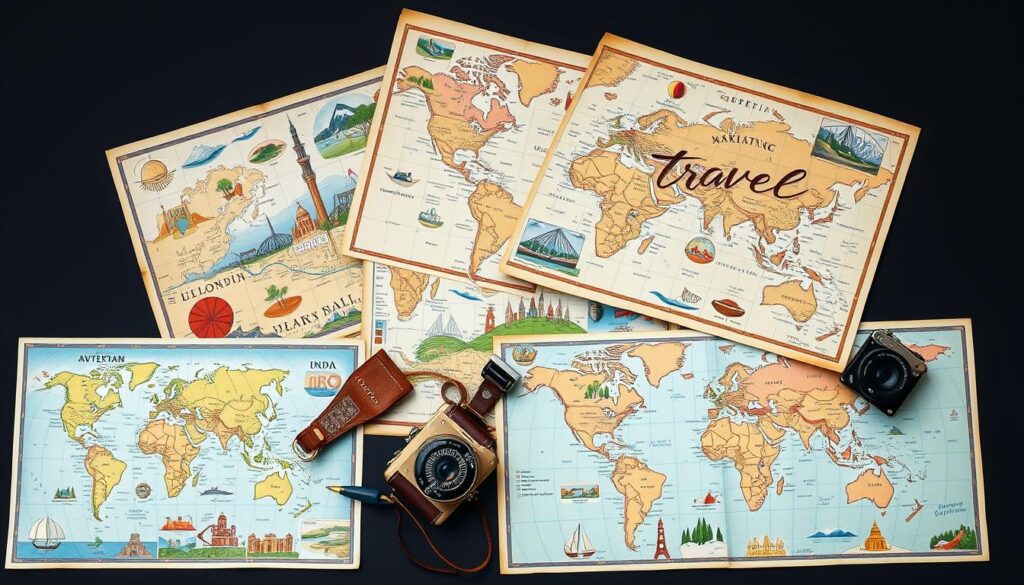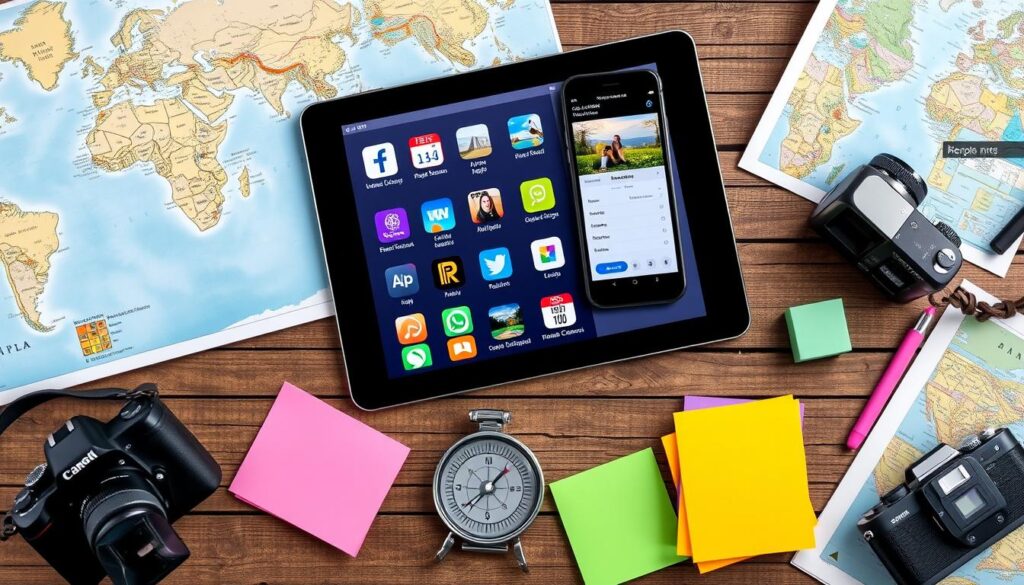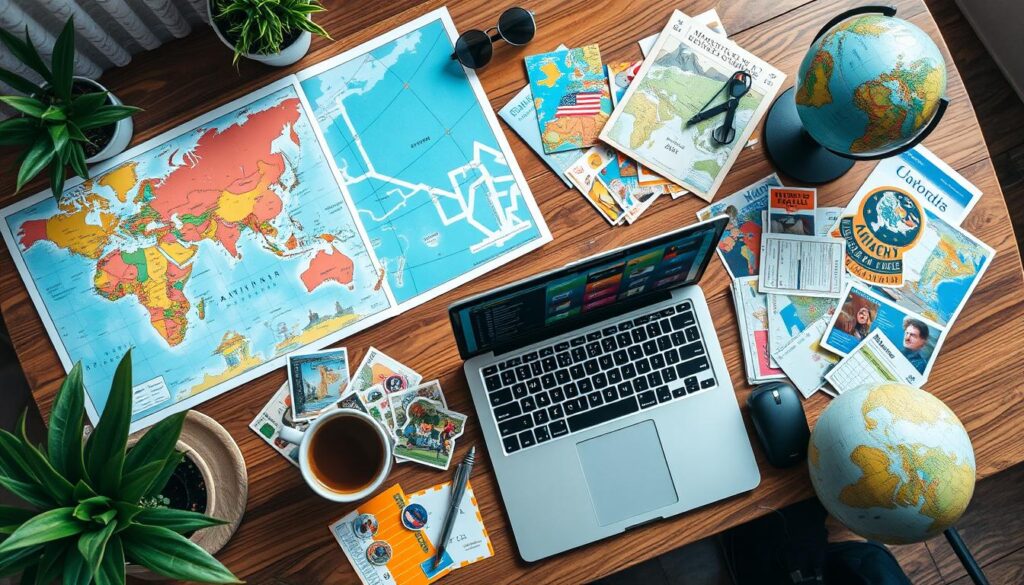תכנון טיול יכול להיות מרגש. תוכנית טיול מסודרת פותחת חוויות בלתי נשכחות. היא מבטיחה שתראה מקומות שחובה לבקר בהם תוך מאפשרות לרגעי רגע.
אסטרטגיה מאוזנת לטיול עוזרת לנהל את הזמן והתקציב בחוכמה. היא מאפשרת לך להתמקד בפעילויות המתאימות לתחומי העניין שלך. מדריך מתוך שקיפות יכול להפוך חופשה טובה לחוויה חד פעמית.
המטרה היא לא לקבוע כל דקה. במקום זאת, צרו מסגרת למסע מעשיר. שקלו מנהגים מקומיים, אפשרויות תחבורה וחוויות אוכל.
הגישה הזו עוזרת ליצור תוכנית טיול חלקה. היא משאירה מקום לרגעים קסומים שלעיתים קרובות מגדירים את הטיולים הכי טובים.
מסקנות מרכזיות
- תוכנית טיול מתוכננת היטב משפרת את חוויית הנסיעה הכוללת שלך
- איזון בין פעילויות מובנות לזמן פנוי לחקירה
- העדיפויות באטרקציות וחוויות על פי תחומי העניין שלך
- שקלו מנהגים מקומיים ואפשרויות תחבורה בתכנון שלכם
- השאירו מקום לגמישות ולגילויים בלתי צפויים
- השתמש בתוכנית הטיול שלך כמדריך, ולא כלוחץ זמנים קפדני
הבנת חשיבות התוכנית המפורטת
תוכנית טיול מפורטת היא מפתח לנסיעה יעילה. היא עוזרת לך להשתמש בזמנך בצורה הטובה ביותר ולהימנע מטעויות. בואו נבחן למה תכנון זה חשוב לאופטימיזצית נסיעה.
מקסימום חווית הנסיעה שלך
תוכנית מקורית מבטיחה שלא תחמק מאטרקציות מרכזיות. היא עוזרת לך לנהל את הזמן וליצור מגוון של חוויות.
תכנון מראש מאפשר לך להזמין סיורים פופולריים מוקדם. בכך, תוכל להימנע מאכזבה ומטורנים ארוכים.
מאזן בין פעילויות והרפיה
חופשת ללא לחץ דורשת את האיזון הנכון. תוכנית טיול טובה משלבת פעילויות מרגשות עם זמן פנוי.
הגישה הזו מונעת עייפות. היא מאפשרת לך ליהנות באמת מכל רגע בטיול שלך.
"אמנות הנסיעה היא אמנות הראייה של מה ששווה לראות, והתעלמות ממה שאינו." – הווארד הילמן
מניעת טעויות נפוצות בנסיעות
רוב הטעויות בנסיעות נגרמות על ידי תכנון חסר. תוכנית פרטית עוזרת לך למנוע חמישה בהזמנות ולא לשער בצורה שגויה את זמני הנסיעה.
זו כלי ערך לאופטימיזצית נסיעות. היא מבטיחה מעברים חלקים ומפחיתה בעיות בלתי צפויות.
| שגיאות נפוצות בנסיעות | איך תוכנית נסיעה מפורטת עוזרת |
|---|---|
| הזמנת פעילויות במידה רבה | מספקת לוח זמנים ריאליסטי עם הפסקות מובנות |
| פספוס אטרקציות חובה | וודא שאתרים עיקריים כלולים ומוזמנים מראש |
| תלות בזמני נסיעה | מתחשבת בתחבורה בין המיקומים |
| התעלמות ממנהגים מקומיים או חגים | משלבת מחקר על תרבות ואירועים מקומיים |
חקירת היעד שלך: היסוד לתוכניות נסיעה נהדרות
חקירת היעד בצורה יעילה חיונית ליצירת תוכניות נסיעה מעולות. היא מציבה את הבמה לחוויה מעשית ואותנטית. התחלו על ידי חיפוש במדריכי נסיעות מהימנים למידע על אטרקציות ומגוון המקומי.
תובנות מקומיות מציעות פרספקטיבה ייחודית על היעד שלכם. התעדפו בקהילות נסיעות מקוונות וקראו בלוגים של יוצאי דופן. התקשרו עם מקומיים דרך רשתות החברתיות כדי לגלות את המגרשים המוסתרים והחוויות המעבר לנתיב המוכר.
הכנה תרבותית מבטיחה נסיעה חלקה וכבודית. למדו על כללי הנאמנות המקומיים, המסורות והמנהגים. הבנה של פרטי התרבות עוזרת למנוע פאו פא חושפני ומקדמת אינטראקציות משמעותיות.
שקלו ללמוד ביטויים בסיסיים בשפה המקומית. זה מעיד על כבוד ומשפר את חוויית הנסיעה שלכם. זה יכול גם לעזור לכם להתחבר למקומיים בקלות יותר.
- חפשו באתרי תיירות רשמיים למידע מעודכן
- קראו בלוגים נסיעות לחוויות אישיות והמלצות
- בדקו בפורומים נסיעות לתובנות טיילים רלוונטיות
- חפשו אירועים מקומיים ופסטיבלים שיתקיימו במהלך ביקורכם
מחקר מעמיק יעזור לכם לקבל החלטות מושכלות לגבי האירוח והתחבורה. זה יאפשר לכם לאחד בין אטרקציות שחובה לראות וחוויות ייחודיות. התוכנית שלכם תותאם לתחומי העניין וההעדפות שלכם.
רכיבים עיקריים של תוכנית נסיעות מקיפה
תוכנית נסיעות יציבה מבטיחה טיול חלק ונעים. בואו נגלה את הרכיבים המרכזיים של תוכנית נהיגה נהדרת. רכיבים אלו יעזרו לכם ליצור הרפתקה בלתי נשכחת.
לוגיסטיקת תחבורה
תכנון ה-לוגיסטיקה של הנסיעה שלכם חיוני. חפשו את הדרכים הטובות ביותר לנסוע ביעד שלכם. שקלו תחבורה ציבורית, השכרת רכב או שירותי שיתוף נסיעה.
הזמינו טיסות, כרטיסי רכבת או כרטיסי אוטובוס מראש. זה עשוי לעזור לכם לקבל מחירים טובים יותר ולוודא זמינות.
הסדרי אירוח
הזמנת אירוח מראש יכולה לחסוך לך מאמץ וכסף. חשוב לשקול את התקציב שלך, המיקום הרצוי והשירותים הנדרשים. בחר בין מלונות, הוסטלים, דירות נופש או אירוח מקומי ייחודי.

אטרקציות חובה ופעילויות
חפש את האטרקציות המבוקשות ביעד שלך. ערך רשימה של המקומות שאינך רוצה לפספס ובדוק את שעות הפעילות שלהם. הזמן כרטיסים מראש לאתרים פופולריים כדי להימנע מתורים ארוכים.
חוויות אוכל וקולינריה מקומית
גילוי המטעמים המקומיים הוא עיקרון של כל טיול. חפש מאכלים מסורתיים ומסעדות פופולריות. ערבב בין אוכל ברמה גבוהה לאוכל רחוב לטעם אמיתי של תרבות מקומית.
הזמן שולחנות במסעדות מבוקשות כדי לוודא את המקום שלך.
| רכיבי נסיעה | טיפים לתכנון |
|---|---|
| תחבורה | השווה מחירים, הזמן מראש, שקול רכישת כרטיסי תחבורה מקומיים |
| אירוח | קרא ביקורות, בדוק מדיניות ביטולים, חפש דילים |
| אטרקציות | הזמן מראש את האתרים הפופולריים, בדוק אפשרויות כרטיסים משולבים, חפש ימי כניסה חינם |
| אוכל | נסה מאכלי מקום, ערבב בין אפשרויות יוקרה לאפשרויות פשוטות, שאל את המקומיים על המלצות |
שקול היטב את הרכיבים החיוניים הללו בעת יצירת תוכנית הנסיעה שלך. שלב בין המעשי לחוויות מרגשות. הגישה הזו תצביע את הבמה למסע מדהים.
התאמת התוכנית שלך לסוגי הנסיעות השונים
התאם את תוכנית הנסיעה שלך לסגנונות שונים. חופשות משפחתיות דורשות פעילויות ידידותיות לילדים וזמן להירגעות. נסיעה בודדים מאפשרת גמישות ורגעים ספונטניים. טיולי הרפתקאות מתמקדים בחוויות שמעלות את האדרנלין.
חופשות יוקרה מדגישות עיסוק בהתענגות וחוויות בלעדיות. האיזון הוא מרכזי לטיולי משפחה. כלול באטרקציות לימודיות ופעילויות כיפיות.

נוסעים בודדים יכולים לארוז חוויות שונות בימים שלהם. כך יכול לכלול טבילה תרבותית ואינטראקציות מקומיות.
טיולי הרפתקאות כוללים לרוב טיולי טיול רגלי, ספורט מים, או מפגשים עם חיות בר.
חופשות יוקרה מעדיפות ארוחות ערב וטיפוח ברמה גבוהה. הן גם מציעות חוויות תרבותיות ייחודיות. עצב את התוכנית שלך כך שתיצור זיכרונות בלתי נשכחים.
"התוכניות הטובות ביותר משקפות את התחושות והצרכים הייחודיים של כל מטייל, יוצרות זיכרונות בלתי נשכחים."
שקול את הגורמים האלה בעת עיצוב התוכנית שלך:
- גודל הקבוצה והדינמיקה בה
- יכולות פיזיות של המטיילים
- הגבלות בתקציב
- זמן השנה ותנאי מזג האוויר
- תחומי עניין תרבותיים והעדפות
| סוג הטיול | שיקולים עיקריים | פעילויות דוגמה |
|---|---|---|
| חופשות משפחתיות | ידידותי לילדים, חינוכי, מרגיע | פארקי עצמאות, מוזיאונים, ימי חוף |
| נסיעה בודדית | גמישות, הזדמנויות חברתיות | סיורי הליכה, שיעורי בישול, צימרים |
| טיולי הרפתקאות | אתגרים פיזיים, חוויות בטבע | טיולי הליכה, צלילה בצלילה, זיפ ליינים |
| חופשות יוקרה | אקסקלוסיביות, טיפוח, אוכל ברמה גבוהה | טיפולי ספא, מסעדות גורמה, סיורים פרטיים |
התאמת התוכנית שלך על מנת להתאים אותה לסגנון הנסיעה שלך. זה ייצור טיול נעים יותר. השאירו מקום לרגעי ההתרגשות ולגילויים בלתי צפויים.
כלים ומשאבים ליצירה וניהול של תוכניות נסיעה
תכנון טיול יכול להיות גם מרגש וגם מעורר לחשש. טכנולוגיה מודרנית מציעה הרבה כלים לפשט את התהליך. משאבים אלה עושים את תכנון הנסיעה הדיגיטלי קל ויעיל.
אפליקציות ואתרי תכנון נסיעות
אפליקציות נסיעות שינו את אופן התכנון שלנו לטיולים. אפשרויות פופולריות כוללות TripIt, Wanderlog ו-Google Trips. אפליקציות אלה מארגנות טיסות, מלונות ופעילויות במקום אחד.
הן עושות את זה קל לגשת לתוכנית הטיול שלך בדרך. אתה יכול לשמור את כל מידע הנסיעה שלך בקרבת יד ומעודכן.

ניהול תוכנית דיגיטלי נגד פיזי
תכנון דיגיטלי מציע מספר יתרונות על פני תוכניות ניווט בנייר. זה קל יותר לעדכן ולשתף עם ליווי בנסיעה. ניתן לגשת לתוכניות שלך מכל מכשיר.
רבים אפליקציות נסיעות עובדות גם במצב לא מקוון. זה מבטיח שלא תאבד בלעדי גישה לאינטרנט.
| מסלולי דיגיטל | מסלולי פיזיים |
|---|---|
| קל לעדכן | זכרון מוחשי |
| ניתן לשיתוף עם אחרים | אין צורך בסוללה |
| נגיש על מספר מכשירים | חסין לכשלי טכנולוגיה |
תכנון שיתופי לטיולי קבוצה
ארגון נסיעות קבוצתי יכול להיות אתגר. תוכנות סידור יומן כמו Travefy ו-Tricount עוזרות לך. פלטפורמות אלה מאפשרות למשתמשים מרובים לתרום ליומן נסיעה אחד.
המשתמשים יכולים להצביע על פעילויות ולחלק עלויות. הגישה הזו מבטיחה שהעדפות של כולם נלקחות בחשבון. זה מביא לטיול נעים יותר עבור כולם.
גמישות ויכולת להסתגלות בתכנון נסיעות
תוכניות נסיעה לעיתים קרובות משנות כיוונם באופן בלתי צפוי. בניית גמישות ביומן שלך היא מרכזית. חוויות ספונטניות עשויות להוביל לרגעים בלתי נשכחים.
אירועים בלתי צפויים עשויים להפריע למסע שלך. השהיות בטיסות, שינויי מזג אוויר, או סגירות פתאומיות עשויים להשבית אותך. גישה גמישה עוזרת לך להתמודד עם ההפתעות הללו בקלות.
- השאר זמן לא מתוכנן בכל יום לחקירה ספונטנית
- חקור פעילויות אלטרנטיביות במקרה של סגירות בלתי צפויות
- הזמן אירוח עם מדיניות ביטול חינמית
- שמור קרן קטנה להוצאות אי צפויות או הזדמנויות
נסיעה נעימה מאזנת בין מבנה לרגעיות. חשוב להכין תוכנית, אך גם להיות פתוח לשינויים. גישה זו עשויה להביא לחוויות ייחודיות ולא מתוכננות.
| תכנון קשוח | תכנון גמיש |
|---|---|
| מצוין כאשר שינויים מתרחשים | מותאם למצבים בלתי צפויים |
| מוגבל לפעילויות שתוכננו מראש | פתוח לגילויים ספונטניים |
| סיכון לאכזבה אם התוכניות נכשלות | הזדמנויות לחוויות ייחודיות |
| גרף זמן מחמיר | מרווח לחקירה מורחבת |
לקבלת גמישות עוזרת לך לנווט בקלות בתקלות בזמן נסיעה. זה מאפשר לך ליהנות למרבה מהמסע שלך. לעתים קרובות, הסיפורים הכי טובים מגיעים מהרפתקאות שלא תוכננו!
מסקנה
סידור נסיעה מסודר הוא מפתח למסע זכור וללא לחץ. על ידי עקיבה אחרי הטיפים הללו, תוכל ליצור תוכנית מאוזנת. התוכנית שלך צריכה למקסם חוויות תוך מענה לצורך בהרפיה.
תכנון נסיעה מוצלח כולל מחקר מעמיק ושקיפות רבה בלוגיסטיקה. זה דורש גמישות. התוכנית שלך צריכה לכלול תחבורה, אירוח, אטרקציות וחוויות אוכל.
כדאי להתאים את האלמנטים הללו לסגנון הנסיעה וליעד שלך. ניתן להשתמש בכלים מודרניים כדי לפשט את תהליך התכנון. זה חשוב בין אם אתה מארגן הרפתקה בודדת או מתארגן טיול קבוצתי.
זכור שגמישות חשובה כמו הכנה. אפילו התוכניות הכי מפורטות עשויות לדרוש שינויים. האסטרטגיות הללו יעזרו לך ליצור חוויות בלתי נשכחות ולהתמודד עם אתגרים במהלך ההרפתקנויות שלך.

